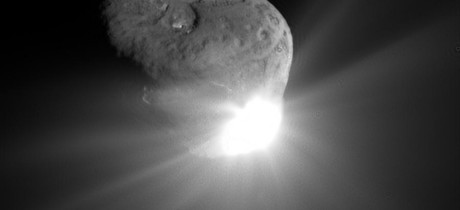Before NASA’s Deep Impact mission, humanity had never probed beneath the surface of a comet.
Launched 12 years ago yesterday on January 12, 2005, the mission released a robotic impactor on a comet called Tempel 1. Named after Ernst Tempel who discovered the comet in 1867, the comet orbits the Sun every 5.5 years and has made many passes through the inner solar system.
A little less than six months after its launch, the mission impacted the comet and provided us with new data about comets and their composition. The team found water ice on the comet!
The impactor spacecraft was made mostly of copper, and operated independently of the flyby spacecraft. The impact ejected debris made of dust and ice that were ejected from the impact crater. The image below was taken 67 seconds after impact by a camera on the mission’s flyby spacecraft.
Image credit: NASA/JPL-Caltech/UMD
Findings from the mission showed that a fine, powdery material was released upon impact into the comet’s nucleus. The mission discovered that the structure of Tempel 1 is fluffy and composed of a fine dust that is held together by gravity. The surface also appeared to have other impact craters.
Upon analyzing the plume that was ejected from the comet after impact, researchers found a big increase of materials that contained carbon. This points to comets having a lot of organic material and that they may have brought the organic material to Earth in the past.
Another interesting mission find was that ice and other material in the comet nucleus may have been unchanged from the solar system’s early days. This is because the interior is shielded from solar heating.
Image credit: NASA/University of Maryland
The mission was a partnership with the University of Maryland, Jet Propulsion Laboratory (JPL) and Ball Aerospace and Technology Corp. It was the eighth NASA Discovery Mission, which are low-cost and highly focused space science investigations.
Learn more about Deep Impact at NASA.gov.



